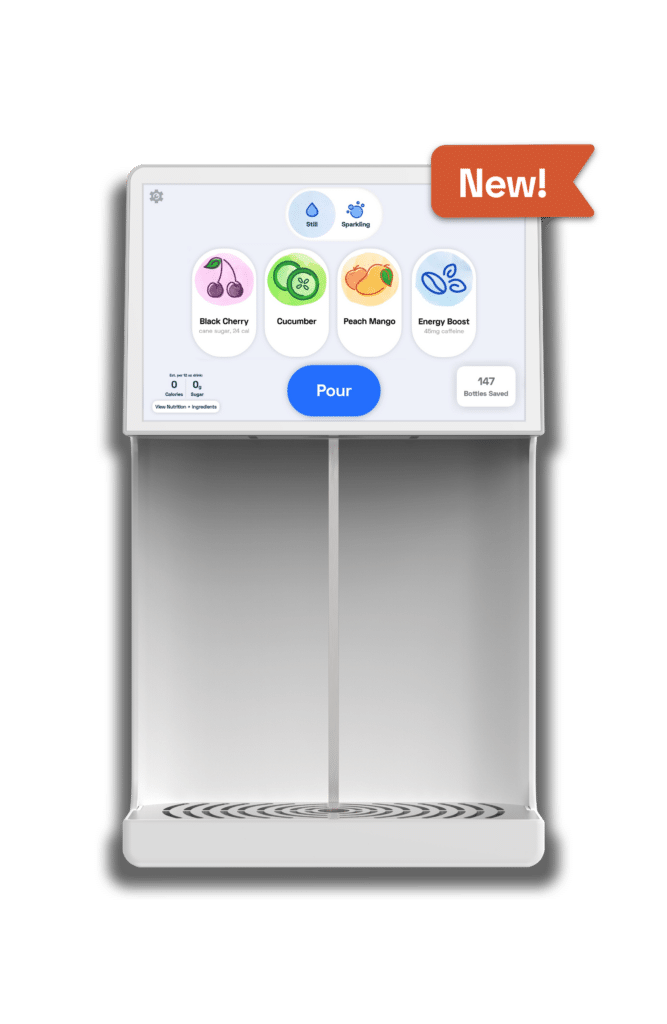January 29, 2025. Plastic is everywhere—from the single-use water bottles on our desks to the clothes we wear. While it’s a convenient staple of modern life, plastic’s environmental impact is staggering. Globally, over 400 million tons of plastic are produced each year, with 50% designed for single use and a meager 10% being reused or recycled.
For too long, we’ve treated recycling and waste reduction as an individual responsibility. While personal choices matter, placing the entire burden of tackling the plastic crisis on individuals—without providing the necessary resources, education, or support—is an overwhelming ask. We need to work collectively to address the growing plastic problem, and the workplace is a powerful environment to lead that change.
7 tips to reduce plastic use at work
From coffee breaks to catered lunches, the convenience of single-use plastics makes them a go-to choice in workplace settings. Lightweight, portable, and requiring no cleanup, items like plastic water bottles, coffee cups, and food packaging simplify busy office life. It’s no wonder the average person uses (and discards) 156 plastic bottles annually. That may seem like a drop in the bucket until you consider that, collectively, Americans discard 2.5 million plastic bottles every hour and the U.S. generates a staggering 35.7 million tons of plastic waste each year—much of it driven by convenience culture.
The good news? Small, intentional changes in the workplace can make a big difference. By rethinking how we approach sustainability, offices can foster eco-friendly habits among employees that extend far beyond the desk. When businesses adopt greener practices, they create a ripple effect—turning routine workdays into opportunities for meaningful environmental impact.Ready to make a difference? Here are seven actionable tips to reduce plastic use and build a greener, more sustainable office environment.
1. Carry a reusable water bottle everywhere you go
One of the most effective ways to reduce plastic waste is to switch to reusable water bottles. The financial case is clear: the average American spends $185.90 on single-use water bottles annually. Encouraging employees to carry reusable bottles not only cuts that cost but also reduces a significant source of plastic waste in the office.
Take it a step further by providing company-branded water bottles. This removes any financial barrier for employees and reinforces your company’s sustainability commitment. It’s a practical move that benefits everyone—employees stay hydrated while doing their part to reduce waste, and a branded bottle doubles as a walking advertisement for your company’s eco-friendly values.But don’t stop at water bottles. Reusable straws are another simple, effective alternative. Consider distributing reusable straw kits as part of onboarding or sustainability-focused initiatives. These kinds of thoughtful changes demonstrate leadership in sustainability and encourage small, everyday habits that can have a lasting impact.
2. Be mindful of the clothes you buy
Plastic isn’t just found in packaging—it’s also woven into our clothes. Many garments, including common office swag like branded t-shirts or uniforms, are made from synthetic fibers like polyester, which shed microplastics every time they’re washed. Businesses can take a more sustainable approach by offering eco-friendly apparel to employees and customers. Here’s how:
- Choose natural fabrics like organic cotton, wool, or linen for branded merchandise and employee uniforms.
- Prioritize ethical sourcing by partnering with suppliers that uphold sustainable and fair trade practices.
- Focus on quality over quantity to ensure apparel lasts longer, reducing the environmental impact of frequent replacements.
By opting for sustainably sourced, natural-fiber clothing, offices can align with their environmental goals while providing employees and customers with swag they’ll feel good about wearing—and that doesn’t contribute to microplastic pollution in our water systems.
3. Switch to digital meeting notes
Paper notes often come with plastic covers, binders, and clips. An easy way to reduce plastic waste is to switch to digital meeting notes using tools like Google Docs, Notion, or Trello. These platforms not only cut down on paper and plastic waste but also make workers more productive.
With the increasing popularity of AI notetaker tools, going digital isn’t just about sustainability—it’s about unlocking new efficiencies. AI tools can automatically transcribe meetings, summarize key points, and send action items to your team, freeing up time to focus on creative and strategic work rather than tedious admin tasks.
Some benefits of going digital include:
- Easier collaboration: Share notes instantly with team members.
- Reduced clutter: No more stacks of paper taking up desk space or rifling through papers trying to find the right document.
- Eco-friendly: Help your office become more sustainable by cutting back on unnecessary paper use.
4. Eliminate single-use plastics in the office kitchen
Your office kitchen is a major contributor to plastic waste, but not all “sustainable” solutions are created equal. Compostable kitchenware—often seen as an eco-friendly alternative to plastic—has been marketed as a step in the right direction. However, recent findings show that compostable products can have a carbon footprint just as high, or even higher, than traditional plastic due to the energy-intensive processes involved in manufacturing them.
What’s worse, many compostable items don’t break down efficiently in industrial composting facilities. Instead, they end up in landfills, where they may not decompose as intended and contribute to plastic contamination.
So, how do you make your office kitchen genuinely greener?
Stock reusable dishware
Replace disposable cups, plates, and cutlery with durable flatware, glassware, and dishware. Stainless steel bowls and reusable containers offer a practical, long-term alternative that drastically reduces waste.
Minimize packaging waste
Partner with eco-conscious suppliers who use minimal or sustainable packaging. Stock bulk snacks in jars or containers instead of offering individually wrapped portions.
Set up specialized recycling programs
Use a dedicated recycling service for single-use plastics like candy wrappers and snack bags that sneak into the office. For example, at Bevi’s HQ we have a designated box for collecting these items so they can be disposed of responsibly, ensuring they don’t end up in landfills.
These changes not only reduce waste but also create a more enjoyable, homey kitchen space.
5. Organize an office supply drive
Hosting an Office Supply Drive is an effective strategy to reduce waste and promote sustainability within your workplace. By collecting unused plastic office supplies like binders, folders, and plastic-coated paperclips, you can facilitate recycling and redistribution, ensuring these items find new purpose instead of ending up in landfills.
Steps for a successful office supply drive:
- Create a Collection Area: Designate a central location in the office where employees can drop off gently used supplies.
- Host a Swap Event: Organize an event where employees can browse and take items they need, fostering a culture of reuse and collaboration.
- Donate Excess Supplies: Partner with local schools or non-profits to donate any remaining items. Not only are you supporting community organizations; you’re also extending the life of standard office supplies.
Implementing such initiatives not only reduces waste but also encourages a more sustainable and resource-conscious workplace culture. For instance, Xavier University’s XU Office Swap program allows faculty and staff to exchange new and gently used office supplies, promoting reuse and minimizing unnecessary purchases.
6. Educate employees on how to reduce plastic use
Creating a sustainable office culture starts with education and practical action. Hosting workshops and partnering with local eco-organizations can empower employees to reduce waste both at work and at home. Interactive events, such as DIY reusable bag-making workshops, foster engagement and help employees connect with sustainability on a personal level.
A key step toward reducing waste is centralizing recycling stations. Studies show that removing individual desk bins and switching to centralized collection points can increase recycling rates by 50% while reducing contamination.
Additionally, clear labeling on recycling stations ensures proper sorting and regular waste audits can identify areas for improvement. The EPA reports that improper sorting leads to nearly 25% of recyclable materials ending up in landfills, emphasizing the need for better recycling practices in offices.
These small, practical changes not only reduce your office’s waste but also contribute to a workplace culture that values sustainability and responsibility—benefiting both employees and the environment.
7. Install a Smart Water Cooler to reduce plastic use with your beverages
One of the most effective ways to cut down on plastic waste in the office is to install a smart water cooler like Bevi. These machines provide flavored sparkling and still water on tap, eliminating the need for plastic water bottles and cans.
Why choose Bevi?
- Reduces waste: Each machine can save thousands and thousands of bottles and cans annually.
- Customizable options: Employees can choose from 48,000 possible drink combinations, making hydration fun and engaging.
- Cost-effective: No more restocking bottled water—a win for both the environment and your budget.
Give Bevi a try
The ripple effect of office sustainability
Reducing plastic waste in the office may seem like a small step, but the impact is bigger than you think. Your office’s carbon footprint is substantial, and by making these changes, you’re contributing to a more sustainable future. Think about the ripple effect: If one office park adopts these practices, the reduction in plastic waste can be staggering.
Start local—make sustainability improvements where you live and work. Small steps can lead to significant change, and inspiring your employees to reduce plastic use can have lasting effects in your community.
Looking for more ways to make your office eco-friendly? Explore our blog for practical tips and inspiration to help your workplace reduce waste and make a mighty impact.






